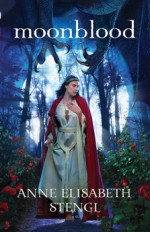Unicorns, goblins, dragons, evil kings, and valiant princes are elements that are not often found together with a message of Christian grace and redemption. In Moonblood and her Tales of Goldstone Wood series, Anne Elisabeth Stengl does just that – with absolutely breathtaking results.
WHAT LED YOU TO WRITE THIS THIRD STORY IN THE TALES OF GOLDSTONE WOOD SERIES?
Moonblood was written almost out of curiosity. I wanted to see if I could take a character from my first novel, Heartless, who is so flawed as to be almost irredeemable and make him into a character that readers would truly love. Prince Lionheart, the hero of Moonblood, is that character. He ends the previous book, Veiled Rose, on a bad note, and starts this one even worse! By the time the plot really gets rolling, it’s hard to see how Lionheart could ever redeem himself. And the truth is, he can’t. But that doesn’t mean he won’t be redeemed.
HOW DID THE STORYLINE FOR MOONBLOOD DEVELOP?
I knew I wanted to set the bulk of this story in the Faerie Realms of my invented world. My first two novels were set primarily in the Real World with magic and danger spilling over from Faerie. Now my main characters needed to be plunged over their heads in the wildness of other worlds! It was as surprising for me as for them… I was just as curious to see what Faerie would look like.
The rest of the story came fairly naturally. The main characters, Lionheart and Rose Red, were well established in the previous novel. Moonblood gave me the opportunity to flesh out Rose Red’s history, which provides the backbone of this plot. With a strong character like Rose Red to shape the story around, plotlines came easily.
HOW DID THE WRITING OF MOONBLOOD DIFFER FROM YOUR OTHER NOVELS?
The biggest challenge of this story was its breadth. Moonblood contains many stories all twining together. While Lionheart is the hero, his path crosses with those of many other characters, each with his/her own distinct motivations. It’s almost an ensemble cast rather than one hero with supporting characters. Figuring out how to tie all those stories together into a believable and satisfying conclusion was a new challenge for me. But one I thoroughly enjoyed!
WHAT IS THE UNDERLYING THEME/MESSAGE OF THE BOOK? IS THIS WHAT YOU SET OUT TO WRITE?
Moonblood is a story of redemption. Lionheart, suffering the effects of his many poor choices and failures, goes on a quest to redeem himself… and discovers along the way that he can’t. Not even offering his own life in exchange for another is enough to wash away the sins of his past. He can never earn himself a right to forgiveness. However, this does not mean that he can never be forgiven. In our current storytelling culture we find many stories of broken heroes doing some good deed to earn forgiveness and the right to heaven. As a born-again Christian, I don’t believe this is possible. No good deed I do will counterbalance the evil of my nature. I don’t believe in karma and I don’t believe in self-righteousness. But I do believe in the awesome power of God’s grace through Christ’s sacrifice.
The spiritual message of Moonblood was not clear to me when I first began drafting the story. I simply intended to have Lionheart, after failing to help Una and betraying Rose Red, set out on a rescue mission and earn himself a hero’s place. I was partway through the story before I recognized the inherent flaw with this plan. And Lionheart himself doesn’t learn it until almost too late…


